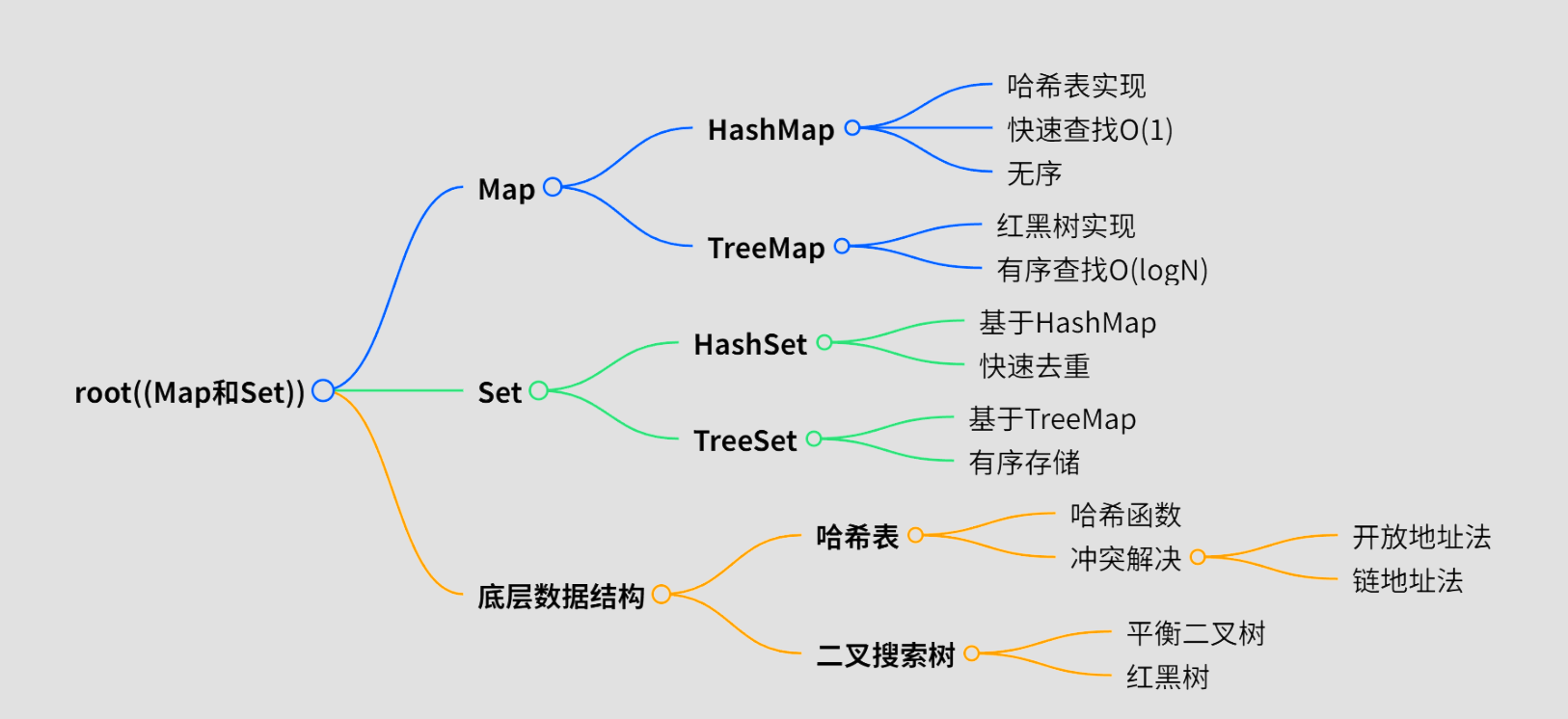初识数据结构——Map和Set:哈希表与二叉搜索树的魔法对决
数据结构专栏 ⬅(click)
大家好!我是你们的老朋友——想不明白的过度思考者!今天我们要一起探索Java中两个神奇的数据结构:Map和Set!准备好了吗?让我们开始这场魔法之旅吧!🎩
🎯 先来点开胃菜:二叉搜索树(BST)
🌳 什么是二叉搜索树?
想象一下,你有一棵神奇的树,左边的果子都比树根小,右边的果子都比树根大!这就是我们的二叉搜索树!
二叉搜索树又称二叉排序树,它或者是一棵空树,或者是具有以下性质的二叉树:
package Tree;//表示树的节点class Node { public int key; public Node left; public Node right; public Node(int key) { this.key = key; } @Override public String toString() { return \"Node{\" + \"key=\" + key + \", left=\" + left + \", right=\" + right + \'}\'; }}public class BinarySearchTree { private Node root = null; //把新的元素插入到树中 public void insert(int key) { //如果当前是空树,那就直接用root指向新节点即可 Node newNode = new Node(key); if (root == null) { root = newNode; } // 如果是普通的树,需要找到哦插入位置,再去进行插入 //cur用来找待插入元素的位置 //parent记录cur的父元素 Node cur = root; Node parent = null; while (cur != null) { if(key<cur.key) { //往左找 parent = cur; cur = cur.left; }else if(key>cur.key) { //往右找 parent = cur; cur = cur.right; }else { //对于相等的情况,存在不同的解决方式 //当前不允许重复key存在,并且是Set只保存key,直接return return; } } //通过上述循环最终得到的结果就是cur为空 //此时的parent就是叶子节点,也就是新插入元素的父亲,此时就是要把newNode插入到parent的子节点上 //新节点,应该在parent的左子树还是右子树呢??直接比较大小 if (key> parent.key){ parent.right = newNode; }else { parent.left = newNode; } } public void remove(int key) { if (root == null) { return; } //查找要删除节点的位置,记录其父节点 Node cur = root; Node parent = null; while (cur != null) { if(key<cur.key) { parent = cur; cur = cur.left; }else if(key>cur.key) { parent = cur; cur = cur.right; }else { //找到了 removeNode(parent, cur); return; } } } private void removeNode(Node parent, Node cur) { //具体删除节点要考虑四种情况 //1.没有子树 if(cur.right == null && cur.left == null) { //1.1如果cur就是root,需要对root进行调整 if(cur == root) { //说明整棵树只有root一个节点,直接把root设置为空 root = null; } //1.2如果cur不是root,同时cur是parent的左子树 if (cur == parent.left) { parent.left = null; return; } //1.3如果cur不是root,同时cur是parent的右子树 if (cur == parent.right) { parent.right = null; return; } //稳妥起见加个return return; } //2.只有左子树 if(cur.left != null && cur.right == null) { //2.1cur为root if(cur == root){ root = cur.left; return; } //2.2cur不为root,且cur是parent的左子树 if (cur == parent.left) { parent.left = cur.left; return; } //2.3cur不为root,且cur是parent的右子树 if (cur == parent.right) { parent.right = cur.left; return; } } //3.只有右子树 if(cur.left == null && cur.right != null) { //3.1只有root if(cur == root){ root = cur.right; return; } //3.2cur不是root,且cur是parent的左子树 if (cur == parent.left) { parent.left = cur.right; return; } //3.3cur不是root,且cur是parent的右子树 if (cur == parent.right) { parent.right = cur.right; return; } } //4.左右都有子树 if(cur.left != null && cur.right != null) { // 这种情况下,不需要考虑 cur 是不是 root的情况,并没有真正的删除 cur指向的节点,即使 cur 是 root,也无需修改 root 的指向 //因为实际删除的是“替罪羊节点” //4.1首先需要找到右子树中的最小值 =>替罪羊, //后续要删除替罪羊,也顺便把替罪羊的父亲,记录一下. Node goat = cur.right; Node goatParent= cur; while (goat.left != null) { goatParent = goat; goat = goat.left; } //循环结束后。goat指向的就是cur右子树的最左侧元素 //4.2移花接木,把替罪羊节点的值复制到cur节点中 cur.key = goat.key; //4.3真正删除goat节点,因为goat是没有左子树的,让goatParent直接连上goat的右子树即可 // 即使goat的右子树也是空也不影响 if(goat == goatParent.left){ goatParent.left = goat.right; }else { goatParent.right = goat.right; } } } //查找key是否在树中,如果存在则返回对应节点位置,如果不存在则返回null private Node find(int key) { if (root == null) { return null; } Node cur = root; while (cur != null) { if(key<cur.key) { cur = cur.left; } else if(key>cur.key) { cur = cur.right; }else { //相等,找到了 return cur; } } return null; } //先序遍历 private static void preOrder(Node root) { if (root == null) { return; } System.out.print(root.key + \" \"); preOrder(root.left); preOrder(root.right); } //中序遍历 private static void inOrder(Node root) { if (root == null) { return; } inOrder(root.left); System.out.print(root.key + \" \"); inOrder(root.right); } public void print(){ //先打印先序遍历 System.out.println(\"先序遍历结果:\"); preOrder(root); System.out.println(); //在打印中序遍历 System.out.println(\"中序遍历结果:\"); inOrder(root); //有了先序和中序就能够画出树的结构 } public static void main(String[] args) { int[] arr = {1, 3, 2, 6, 5, 7, 8, 9, 10, 0}; //BinarySearchTree也总被缩写成BST BinarySearchTree tree = new BinarySearchTree(); //循环插入 for(int key: arr){ tree.insert(key); } tree.print(); System.out.println(); System.out.println(tree.find(7)); }}🎭 BST的表演时刻
💡 小贴士:Java中的TreeMap和TreeSet就是用红黑树(BST的升级版)实现的哦!
🎩 主角登场:Map和Set
🗺️ Map:你的万能字典
Map就像你的通讯录,名字(Key)对应电话(Value),而且名字不能重复!
Map<String, String> heroNicknames = new HashMap<>();heroNicknames.put(\"林冲\", \"豹子头\");heroNicknames.put(\"李逵\", \"黑旋风\");heroNicknames.put(\"宋江\", \"及时雨\");// 获取外号System.out.println(heroNicknames.get(\"林冲\")); // 输出:豹子头// 遍历所有英雄for (Map.Entry<String, String> entry : heroNicknames.entrySet()) { System.out.println(entry.getKey() + \"的外号是:\" + entry.getValue());}
- Tip:使用put方法时:
若key不同,value相同则新增键值对
若key相同,value不同则为修改对应的value
🎭 Map的两种实现对比
🎪 Set:独一无二的马戏团
Set就像一个不允许重复演员的马戏团,每个演员都是独一无二的!
Set<String> fruitSet = new HashSet<>();fruitSet.add(\"苹果\");fruitSet.add(\"香蕉\");fruitSet.add(\"橙子\");fruitSet.add(\"苹果\"); // 这个不会被添加进去System.out.println(fruitSet.contains(\"香蕉\")); // 输出:trueSystem.out.println(fruitSet.size()); // 输出:3🎭 Set的两种实现对比
🔮 哈希表:数据结构的魔法帽
🎩 哈希函数:魔法咒语
哈希函数就像把名字变成数字的咒语:
int hashCode = \"魔法\".hashCode(); // 返回一个魔法数字⚡ 哈希冲突:当两个咒语撞车了
当不同的Key计算出相同的哈希值,就发生了冲突!我们有几种解决办法:
-
开放地址法(线性探测/二次探测)
- 线性探测:h(key) = (h(key) + i) % size
- 二次探测:h(key) = (h(key) + i²) % size
-
链地址法(哈希桶)
- 每个位置放一个链表,冲突的元素都挂在链表上
🌟 哈希桶实现:我们的魔法实验室
public class MyHashMap { //利用链表去解决哈希冲突,利用一个静态内部类Node来表示链表节点 static class Node{ public int key; public int value; public Node next; public Node(int key, int value) { this.key = key; this.value = value; } } //一般来说这个数组的长度的设定也是有技巧的 // 一个典型的做法是选择素数作为数组的长度,减少哈希冲突的概率 private Node[] table = new Node[1001]; //记录有效元素的个数 private int size; //设定哈希函数,把key转成数组下标 private int hashCode(int key){ return key % table.length; } //哈希表的核心操作 //插入/修改操作 public void put(int key, int value) { //1.根据key,计算出下标位置 int index = hashCode(key); //2.遍历链表,看一下key是否在链表中已经存在 Node head = table[index]; for(Node cur = head; cur != null; cur = cur.next){ //如果已经存在,就修改对应的value值 if(cur.key == key){ cur.value = value; return; } } //3.如果不存在直接插入,按照头插方式插入 Node newNode = new Node(key, value); newNode.next = head; table[index] = newNode; //4.插入完成后size要自增 size++; //5.扩容(考虑负载因子) if((double)size/table.length > 0.75){ resize(); } } //扩容 private void resize(){ //创建一个更大的数组,直接遍1.5倍,更好的方法找一个刚好大于原来size的2倍多一点的素数 Node[] newTable = new Node[table.length + table.length>>1]; //搬运,把原来table中的元素搬运过来 for(int i = 0; i < table.length; i++){ for (Node cur = table[i]; cur != null; cur = cur.next){ //根据这个节点,创建新节点,插入到新数组中 Node newNode = new Node(cur.key, cur.value); int newIndex = cur.key % newTable.length; //把新节点头插到新的链表中 newNode.next = newTable[newIndex]; newTable[newIndex] = newNode; } } //替换操作 table = newTable; } //根据键获取值 public Integer get(int key) { //1.根据key计算出下标 int index = hashCode(key); //2.在对应的链表上找到该key的值 for(Node cur = table[index]; cur != null; cur = cur.next){ if(cur.key == key){ return cur.value; } } //3.通过上述循环都没有找到就返回null return null; } //删除键值对,本质上就是链表删除 public void remove(int key) { //1.根据key找到下标 int index = hashCode(key); //2.先考虑链表为空的情况,直接返回,不需要删除 if(table[index] == null) return; //考虑是否为头节点情况 if(table[index].key == key){ table[index] = table[index].next; size--; return; } //再考虑普通情况 Node prev = table[index]; Node cur = prev.next; while (cur != null) { if(cur.key == key){ prev.next = cur.next; size--; return; } prev = cur; cur = cur.next; } }}📊 哈希表性能分析
🎯 实战演练:OJ题目解析
1. 只出现一次的数字
题目:给定一个非空整数数组,除了某个元素只出现一次以外,其余每个元素均出现两次。找出那个只出现了一次的元素。
魔法解法:使用异或运算的特性!
public int singleNumber(int[] nums) { int result = 0; for (int num : nums) { result ^= num; } return result;}2. 宝石与石头
题目:给定字符串J代表宝石的类型,S代表你拥有的石头。你想知道你拥有的石头中有多少是宝石。
魔法解法:使用HashSet!
public int numJewelsInStones(String J, String S) { Set<Character> jewels = new HashSet<>(); for (char c : J.toCharArray()) { jewels.add(c); } int count = 0; for (char c : S.toCharArray()) { if (jewels.contains(c)) count++; } return count;}🎓 知识总结:思维导图

🎉 结语:选择你的魔法武器
今天我们一起探索了Map和Set的魔法世界,从二叉搜索树到哈希表,从TreeMap到HashMap,每个数据结构都有它独特的魔法特性!
记住:
- 需要快速查找?选HashMap/HashSet!
- 需要有序存储?选TreeMap/TreeSet!
- 遇到哈希冲突?试试链地址法!
希望这篇博客能像魔法一样帮助你理解这些数据结构!





